Introduction
Franchising can be a powerful tool for businesses looking to expand internationally. As an alternative to expanding corporately, it allows a brand to reach more markets quicker, and leverages off the capital investment, and local expertise and infrastructure of the franchisee.
Before setting off on this journey, the prospective franchisor should carry out the following steps, or ask the following questions of itself:
- Does the business understand the franchise model, and how it might apply to its business model? This question will have been answered if the business has franchised in its domestic market, but some businesses only franchise internationally.
- Does the business understand how it will operate across borders, and how it will support an international franchisee?
- Does the business know where it wants to go? Franchising as a response to a flattering enquiry is common, but that is not a longterm strategy.
- Does the business have access to legal advisors who specialise in this area, and what are the main legal options for structuring a franchising deal?
This article is the first in a two-part series on international franchising. This article focuses on the last of the above questions and the second article will explore some of the other issues in more detail.
Below is a summary of the key legal models that are used in international franchising (many of these also feature in domestic franchising to smaller or larger degrees). An immediate point to note is that one size does not fit all. Franchisors may deploy different models depending on the market, the risk appetite and the size of the opportunity. Nevertheless, whichever model is used, the core legal and operational terms should be as consistent as possible.
Direct franchising
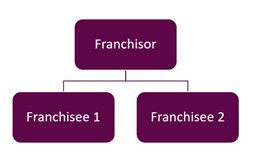
The franchisor grants a third party the right to operate a franchise for a defined number of years.
The benefit of single unit franchising is that it offers a high level of consistency and control. Depending on the brand or volume of units, a unit franchise agreement is often presented as a standard form, take-it or leave-it agreement.
Unit franchising is suitable for smaller-scale rollouts (eg, a fine-dining concept or pilot store). However, it requires greater investment in support from the franchisor.
If a franchisor is looking to establish multiple franchises in the territory, this may not be the best model, unless the franchisor is prepared to establish a presence in the market to:
- help support and monitor franchisees;
- promote the business centrally; and
- establish supply chains.
Direct unit franchising can be useful to test markets as a precursor to a roll out using a different model (eg, Wendy's in the United Kingdom appointed the entity REEF to open dark kitchens) or it can be used for other purposes (eg, using a temporary pop-up franchise to secure or maintain trademark registrations).
Development franchising
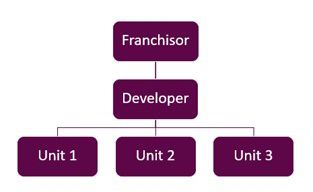
Development franchising involves:
- multiple units with a single franchisee;
- a higher investment for a franchisee; and
- is commonly used in the retail, food and beverage and leisure sectors.
A multiple-unit development structure allows a franchisor to grant a third-party franchisee the right to operate more than one franchise of the franchised business within a defined territory. The "developer" franchisee may be granted exclusive, sole or non-exclusive rights with the territory and/or within certain channels.
However, does the developer, who will be responsible for opening and operating multiple franchises, have the capacity and resources to deliver? Development franchising is very common, but it naturally results in less control for the franchisor and/or greater control for the developer and more in-depth negotiations over commercial and legal terms.
Businesses should be wary of granting immediate territorial exclusivity and should consider starting smaller and then granting further rights in additional territories or channels if the developer hits its development milestones.
To document this structure, a business will enter into a multi-unit development agreement with the developer and either issue short operating certificates for each franchise, or enter into separate franchise agreements (eg, a unit franchise agreement) for each franchise. A third option is to separate the development rights from the operating rights by creating two agreements, with operating certificates issued under the operating agreement. The key challenge is finding the right partner with the right level of experience and access to capital (the pool of candidates is naturally smaller than unit franchisees), particularly in an unfamiliar jurisdiction.
Businesses should also be aware of multi-jurisdictional deals under one agreement as it could be a master franchise agreement in disguise (ie, the developer will need to sub-licence to third parties in order to access the full market).
Master franchising
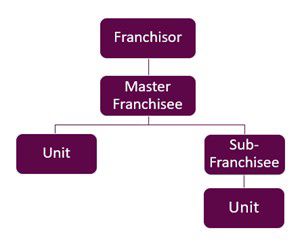
A master franchise structure grants a third party, known as a master franchisee, the right to sub-franchise rights in a territory to unit or multi-unit franchisees. The rights granted to the master franchisee are often for a whole country or region, and the structure means that the master franchisee is effectively acting as the franchisor for that territory.
It may be a term of the master franchise agreement that the master franchisee opens a pilot unit franchise to show proof of concept in the local market and/or maintain a minimum number of its own units for the purposes of training and recruiting sub-franchisees, and piloting new products and services. In this respect, the master franchisee is acting like a developer, or unit franchisee.
In relation to third party sub-franchisees, the master franchisee will be responsible for promoting the franchise opportunity and recruiting, training and appointing sub-franchisees (just like the franchisor would do in unit franchising).
This requires the master franchisee to have two skill sets – operator and franchisor, which in turn requires the development of two types of manual.
This contractual structure means that the franchisor will have no direct control over the sub-franchisees and, therefore, a greater level of trust is given to the master franchisee to effectively operate and police its network.
Termination or expiry is a key point to consider. What happens to the sub-franchisees who are dependent on the master franchisee if the master franchise agreement is terminated or expires? Another point to consider, which arises in this multi-tier structure, is the distinction between the master franchise agreement (which is typically subject to the franchisor's domestic law) and the unit franchise agreement (which is typically subject to the master franchisee's domestic law, as it is a contract between two local entities). How are these agreements best aligned? Can a franchisor have direct rights of enforcement against a sub-franchisee, but no direct obligations? What is the master franchisee's liability for the breaches of a sub-franchisee?
The benefit of this structure does mean that less of the franchisor's resource is spent managing the territory and, therefore, it can be a good source of revenue for the franchisor for little capital investment. Several global brands operate on this basis, and master franchising can also be used in the context of joint ventures, where the franchisor and the local partner are shareholders in the master franchisee/joint venture company.
Joint venture franchises
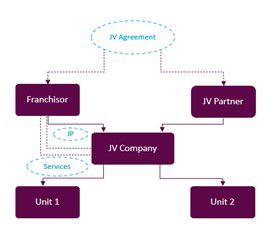
From the outset, the name itself is misleading. It implies that the joint venture and franchise are one and the same, often documented within one legal contract – a joint venture franchise agreement. That perception is the root cause of many problems encountered with this model. A "joint venture franchise" is shorthand for the grant of a franchise to a joint venture party.
There are many reasons why a franchisor might consider adopting a joint venture structure, but they often involve two, diametrically opposed, objectives. Either the franchisor wishes to exert greater control over the franchisee, or it wishes to show greater commitment to the franchisee by committing its own resources to the franchise. Other factors that may influence the decision to adopt a joint venture model include:
- legal necessity (some jurisdictions require a franchisor to open and operate its own corporate units before it can set up a pure franchise network);
- a desire to test a market (a joint venture can be used to test the concept in a new market before employing a pure franchise model); or
- the franchisor ultimately wanting to take control of the market by way of a future strategic buy-out.
With a joint venture franchise, the franchisor maintains its contractual control through the terms of the franchise agreement, but this is underpinned by a further layer of control at a corporate level through the joint venture or shareholder arrangement. By taking an equity interest in and possibly a seat on the board of the franchisee company the franchisor can influence, and potentially direct, the conduct of the franchisee business. This influence can extend to all aspects of the franchisee's internal operations including recruitment, site selection, business planning and pricing.
A complete joint venture may require the franchisor to invest capital into the joint venture franchisee (negating one of the benefits of franchising) and/or it may require the franchisor's employees to be involved in the day-to-day operations and management of the joint venture franchisee (again, negating one of the common benefits of franchising) and also raising the risk of a conflict of interests, or even establishing a taxable presence in the local market. On the upside, in addition to exerting greater control, a franchisor gets a share of profit as well as income under the franchise agreement.
Strategic joint ventures
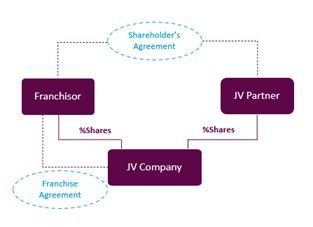
Another option is a strategic joint venture where the franchisor makes a smaller capital contribution and/or takes a smaller minority stake but has some clearly defined roles and objectives for the joint venture.
This could be used to facilitate a future buyback, or to provide greater control or input over brand-critical issues if the joint venture partner's strengths lie elsewhere (ie, access to real estate, government connections and/or capital).
Overall, a strategic joint venture:
- preserves control and includes a lower investment risk;
- has a clear strategic purpose as it:
-
- eases corporate market entry;
- facilitates higher exit value; and
- can improve relationship with developer; and
- provides a clearer distinction between roles (ie, franchisor and shareholder, governance and operational or brand control).
However, as with typical fifty-fifty joint ventures, strategic joint ventures come with some downsides as they:
- are not attractive for some partners;
- are expensive to set-up properly;
- have direct investment issues; and
- can have conflict issues that are not completely resolved.
Comment
The structures referred to above are not exhaustive (eg, master representative franchising has been used by brands such as Subway) but this article aims to demonstrate the malleable nature of the franchising model and, therefore, shows the importance of using legal counsel that specialises in this area.
Originally published 19/09/2023
The content of this article is intended to provide a general guide to the subject matter. Specialist advice should be sought about your specific circumstances.


